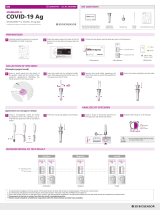
SARS-CoV-2
Rapid Antigen Test Nasal
Quick Reference Guide
This guide is a reference for using the
SARS-CoV-2 Rapid Antigen Test Nasal.
Read the Instructions for Use before using this test.
0 9368221001 (01) 2021-01 EN
Warning!
Follow all health and safety regulations.
• Use appropriate personal protective equipment.
• Handle all samples as if they contain infectious
agents.
• Observe all precautions and warnings in the
Instructions for Use.
Important safety information
1. Tilt the patient’s head slightly back
(approx. 70° angle).
2. Insert sterile swab into the nostril with the most
secretion.
3. Insert the sterile swab into the nostril with the most
secretion. While rotating the swab, insert the swab
2cm (slightly less than 1inch) parallel to the palate
(not upwards) towards the throat into the nostril
until resistance is met at turbinates. Do not apply
pressure.
2Collecting and preparing nasal sample
4. Rotate the swab 4 times for about 15seconds
against the nasal wall and remove it from the
nostril.
5. Repeat step 3 to 4 with the same swab in the other
nostril.
Note: Samples must be collected from both nostrils
using the same swab.
Left nostril Right nostril
4x 4x
6. Insert the swab into an extraction buffer tube.
While squeezing the buffer tube, stir the swab more
than 10 times.
7. Remove the swab while squeezing the sides of the
tube to extract the liquid from the swab.
>10x
WARNING! Failure to squeeze the tube can lead to
incorrect results due to excess buffer in the swab.
8. Press the nozzle cap tightly onto the tube.
Continue with 3 Performing a test.
SD Biosensor, Inc.
C-4th&5th, 16,
Deogyeong-daero 1556beon-gil,
Yeongtong-gu, Suwon-si,
Gyeonggi-do, 16690,
REPUBLIC OF KOREA
Made in Korea
Authorized representative:
MT Promedt Consulting GmbH
Altenhofstrasse 80
D-66386 St. Ingbert, Germany
Distributed by:
Roche Diagnostics GmbH
Sandhofer Strasse 116
D-68305 Mannheim, Germany
www.roche.com
For in vitro diagnostics use only
Not for self testing
© 2020. All rights reserved.
Document information
Document version: Initial version
Revision date: January, 2021
1Preparing for a test
1. Carefully read the Instructions for Use for the
SARS-CoV-2 Rapid Antigen Test Nasal.2. Check the expiry date on the back of the foil
pouch. Do not use the test if the expiry date has
passed.
/ LOT No.
/ MFG DATE
/ EXP DATE
/ REF No.
Distribution by:
Manufactured by:
LOT
REF
SARS-CoV-2 Rapid Antigen Test Nasal
3. Open the foil pouch and remove the test device and
the desiccant package.
4. Ensure that the test device is undamaged and that
the desiccant status indicator shows valid (yellow).
1. A colored line appears in the top section of the
result window to show that the test is working
properly. This is the control line (C). Even if the
control line is faint, the test should be considered
to have been performed properly. If no control line
is visible the test is invalid.
2. In case of a positive result, a colored line appears
in the lower section of the result window. This is the
test line (T). Even if the test line is very faint or not
uniform, the test result should be interpreted as a
positive result.
4Interpreting results
Positive Negative Invalid
Note: The presence of any test line no matter how faint, together with a control line, should be considered as a positive result.
For diagnostic purposes, the results should always be assessed in conjunction with the patient’s medical history, clinical examination, and other ndings.
Control line
Test line
3Performing a test
1. Place the test device on a at surface and apply
4 drops of extracted sample at a 90º angle to the
specimen well of the test device.
4 drops
2. Read the test result at 15 to 30 min.
WARNING! Risk of incorrect results. Do not read
the test result after 30 min.
15 - 30 min
5Performing a QC (as required)
1. Put the positive or negative control swab into an
extraction buffer tube. Stir the swab more than 5
times.
>5x
2. Remove the swab while squeezing the sides of the
tube to extract the liquid from the swab.
3. Press the nozzle cap tightly onto the tube.
4. Place the test device on a at surface and apply
3 drops of extracted sample at a 90º angle to the
specimen well of the test device.
3 drops
5. Read the test result at 15 to 30 min as described in
4 Interpreting results.
WARNING! Risk of incorrect results. Do not read
the test result after 30 min.
15 - 30 min
SARS-CoV-2-RAGT-NASAL_1-0_QRG_1-0_09368221001-01_EN_final-3b.indd 1 1/27/2021 11:58:01 AM




